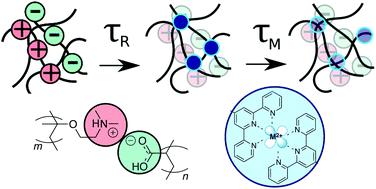当前位置:
X-MOL 学术
›
Soft Matter
›
论文详情
Our official English website, www.x-mol.net, welcomes your feedback! (Note: you will need to create a separate account there.)
Complex coacervation and metal–ligand bonding as synergistic design elements for aqueous viscoelastic materials
Soft Matter ( IF 3.4 ) Pub Date : 2021-3-3 , DOI: 10.1039/d0sm02236e Alexei D. Filippov 1, 2, 3, 4 , Joris Sprakel 1, 2, 3, 4 , Marleen Kamperman 4, 5, 6, 7
Soft Matter ( IF 3.4 ) Pub Date : 2021-3-3 , DOI: 10.1039/d0sm02236e Alexei D. Filippov 1, 2, 3, 4 , Joris Sprakel 1, 2, 3, 4 , Marleen Kamperman 4, 5, 6, 7
Affiliation

|
The application of complex coacervates in promising areas such as coatings and surgical glues requires a tight control of their viscous and elastic behaviour, and a keen understanding of the corresponding microscopic mechanisms. While the viscous, or dissipative, aspect is crucial at pre-setting times and in preventing detachment, elasticity at long waiting times and low strain rates is crucial to sustain a load-bearing joints. The independent tailoring of dissipative and elastic properties proves to be a major challenge that can not be addressed adequately by the complex coacervate motif by itself. We propose a versatile model of complex coacervates with customizable rheological fates by functionalization of polyelectrolytes with terpyridines, which provide transient crosslinks through complexation with metals. We show that the rheology of the hybrid complexes shows distinct footprints of both metal–ligand and coacervate dynamics, the former as a contribution very close to pure Maxwell viscoelasticity, the latter approaching a sticky Rouse fluid. Strikingly, when the contribution of metal–ligand bonds is dominant at long times, the relaxation of the overall complex is much slower than either the “native” coacervate relaxation time or the dissociation time of a comparable non-coacervate polyelectrolyte–metal–ligand complex. We recognize this slowing-down of transient bonds as a synergistic effect that has important implications for the use of complementary transient bonding in coacervate complexes.
中文翻译:

复杂凝聚和金属-配体键合作为水性粘弹性材料的协同设计元素
复杂凝聚层在有前景的领域(例如涂料和外科用胶)中的应用要求严格控制其粘性和弹性行为,并对相应的微观机理有敏锐的理解。虽然粘性或耗散的外观在预设时间和防止脱落方面至关重要,但长时间等待和低应变率下的弹性对于维持承重关节至关重要。耗散和弹性特性的独立调整被证明是一个重大挑战,而复杂的凝聚层本身无法充分解决这一难题。我们提出了一种通用的复杂凝聚层模型,可通过将聚电解质与三联吡啶官能化来实现可定制的流变学命运,通过与金属的络合提供瞬态交联。我们表明,杂化复合物的流变学表现出金属-配体和凝聚态动力学的独特足迹,前者的贡献非常接近纯麦克斯韦粘弹性,后者接近粘性的Rouse流体。令人惊讶的是,当金属-配体键的贡献长期处于支配地位时,整体配合物的弛豫要慢于“天然”凝聚层弛豫时间或相当的非凝聚态聚电解质-金属-配体络合物的解离时间。我们认识到这种瞬态键的减慢是一种协同效应,对于在凝聚层中使用互补的瞬态键具有重要的意义。后者接近粘性的Rouse液。令人惊讶的是,当金属-配体键的贡献长期处于支配地位时,整体配合物的弛豫要慢于“天然”凝聚层弛豫时间或相当的非凝聚态聚电解质-金属-配体络合物的解离时间。我们认识到这种瞬态键的减慢是一种协同效应,对于在凝聚层复合物中使用互补的瞬态键具有重要的意义。后者接近粘性的Rouse液。令人惊讶的是,当金属-配体键的贡献长期处于支配地位时,整体配合物的弛豫要慢于“天然”凝聚层弛豫时间或相当的非凝聚态聚电解质-金属-配体络合物的解离时间。我们认识到这种瞬态键的减慢是一种协同效应,对于在凝聚层复合物中使用互补的瞬态键具有重要的意义。
更新日期:2021-03-03
中文翻译:

复杂凝聚和金属-配体键合作为水性粘弹性材料的协同设计元素
复杂凝聚层在有前景的领域(例如涂料和外科用胶)中的应用要求严格控制其粘性和弹性行为,并对相应的微观机理有敏锐的理解。虽然粘性或耗散的外观在预设时间和防止脱落方面至关重要,但长时间等待和低应变率下的弹性对于维持承重关节至关重要。耗散和弹性特性的独立调整被证明是一个重大挑战,而复杂的凝聚层本身无法充分解决这一难题。我们提出了一种通用的复杂凝聚层模型,可通过将聚电解质与三联吡啶官能化来实现可定制的流变学命运,通过与金属的络合提供瞬态交联。我们表明,杂化复合物的流变学表现出金属-配体和凝聚态动力学的独特足迹,前者的贡献非常接近纯麦克斯韦粘弹性,后者接近粘性的Rouse流体。令人惊讶的是,当金属-配体键的贡献长期处于支配地位时,整体配合物的弛豫要慢于“天然”凝聚层弛豫时间或相当的非凝聚态聚电解质-金属-配体络合物的解离时间。我们认识到这种瞬态键的减慢是一种协同效应,对于在凝聚层中使用互补的瞬态键具有重要的意义。后者接近粘性的Rouse液。令人惊讶的是,当金属-配体键的贡献长期处于支配地位时,整体配合物的弛豫要慢于“天然”凝聚层弛豫时间或相当的非凝聚态聚电解质-金属-配体络合物的解离时间。我们认识到这种瞬态键的减慢是一种协同效应,对于在凝聚层复合物中使用互补的瞬态键具有重要的意义。后者接近粘性的Rouse液。令人惊讶的是,当金属-配体键的贡献长期处于支配地位时,整体配合物的弛豫要慢于“天然”凝聚层弛豫时间或相当的非凝聚态聚电解质-金属-配体络合物的解离时间。我们认识到这种瞬态键的减慢是一种协同效应,对于在凝聚层复合物中使用互补的瞬态键具有重要的意义。


























 京公网安备 11010802027423号
京公网安备 11010802027423号